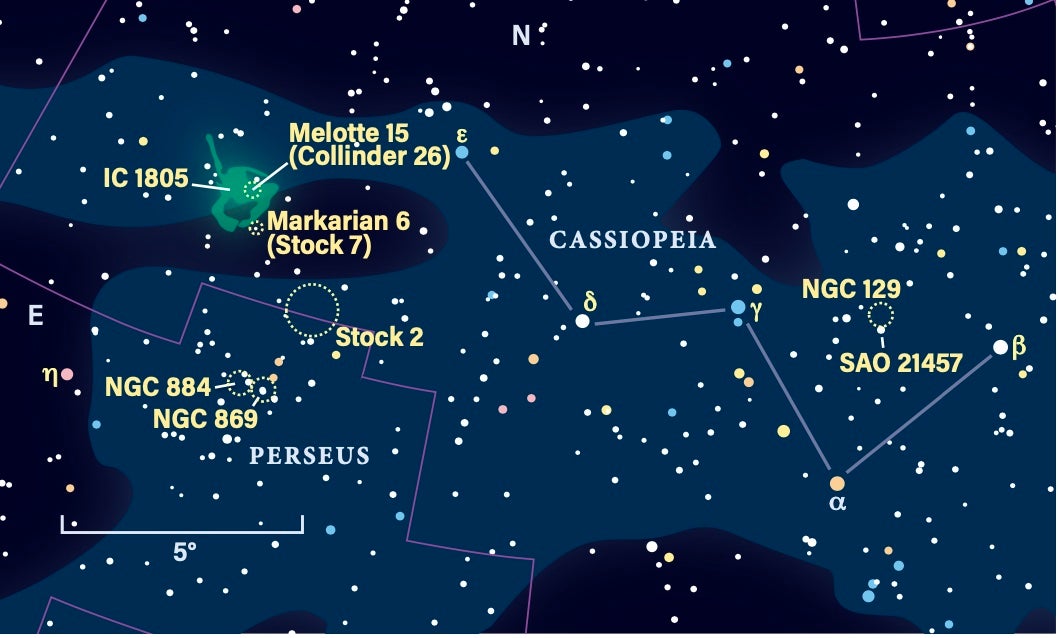
Cassiopeia the Queen reigns over one of the richest regions of the Milky Way north of the celestial equator. This month, we visit some of her lesser-known subjects.
Let’s begin with open cluster NGC 129. This one is easy to find, as it sits almost exactly halfway between Caph (Beta [β] Cassiopeiae), which marks the western end of the constellation’s familiar W pattern, and Gamma (γ) Cassiopeiae at the W’s center. Aim there and you’ll find the 6th-magnitude star SAO 21457 and, just to its north, a small blur — that’s the open cluster. NGC 129 shines at 7th magnitude and holds some three dozen stars in its grip. Many shine below binocular visibility, however. You’ll know you’re in the right place when you find three 9th-magnitude stars in a tight equilateral triangle, surrounded by a dim glow. The brightest member of the triangle is the golden-colored Cepheid variable star DL Cassiopeiae.
Next, zigzag your way across the W to Epsilon (ε) Cassiopeiae at the eastern end. About 10½° to Epsilon’s southeast is 4th-magnitude Eta (η) Persei. Halfway between the two is our next target, the bite-sized cluster Stock 7 (also known as Markarian 6). This tiny congregation holds some 29 stars, although the exact number is hard to pin down given the rich surroundings. Viewing through my 10×50 binoculars, I can spot four 8th- to 9th-magnitude stars set in a short, fuzzy arc curving north-southwest. My larger 16x70s add several fainter stars that together form a cruciform shape, with two 11th-magnitude stars creating the crossbeam. Other observers have commented that the shape reminds them of a croissant or an arrow pointing south. Even larger binoculars show that the southernmost star belongs to a tight collection of four points, creating a pretty scene against the starry backdrop.
A 1980 paper in the Publications of the Astronomical Society of the Pacific, entitled “A Small Cluster Near IC 1805,” examined whether Markarian 6 was a true open cluster and if it was associated with the nearby large Hydrogen-II region IC 1805, nicknamed the Heart Nebula. The cluster overlaps the southern edge of the nebula. The results showed that it is in fact a genuine cluster and lies 1,600 light-years from us. The nebula, however, is believed to be 7,200 light-years away.
The Heart Nebula is tough to make out through binoculars, but might be possible by using a pair of UHC filters.
Markarian 6 may not lie within IC 1805, but another cluster does. Marking the heart of the Heart Nebula, Melotte 15 (also cataloged as Collinder 26) is a sparsely packed grouping spanning 21′ and containing about 40 blue-white and white stellar infernos. The three brightest stars shine at 7th and 8th magnitudes and form an obtuse arrowhead aimed northwest. A fourth 9th-magnitude star at the eastern edge of the cluster serves as the arrow’s shaft.
Since we are so close, let’s pay a visit to open cluster Stock 2. You may know it as the Muscleman Cluster. This name was bestowed upon it by my friend, the late John Davis of Amherst, Massachusetts, three decades ago, and it really caught on. The cluster’s stick figure is oriented with the head to the west and the feet to the east. Both arms curl upward, as if he is flexing his muscles.
But recently, I read of another nickname that I thought was also very good because it includes the surroundings: the Dog Walker. First, look beyond Stock 2, across the border into Perseus. There lies the beautiful Double Cluster, NGC 869 and NGC 884. They are always one of my first stops whenever I head out this time of year. They also make finding Stock 2 easy, thanks to an arc of stars that curves northwestward toward the Muscleman.
Incorporating this arc of stars and the Double Cluster is what forms the Dog Walker. Stock 2’s stick figure is walking the dogs — the Double Cluster — with the arc forming the leash. As a lifelong dog owner, I especially appreciate this broad asterism.









